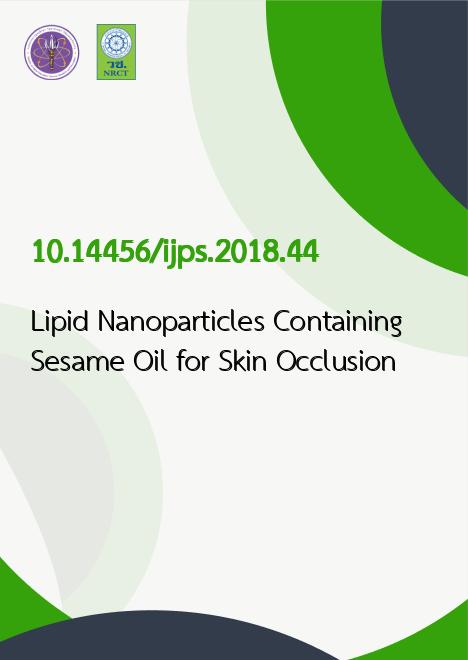
|
Lipid Nanoparticles Containing Sesame Oil for Skin Occlusion |
|---|---|
| รหัสดีโอไอ | |
| Creator | Walaiporn Tiaprasit |
| Title | Lipid Nanoparticles Containing Sesame Oil for Skin Occlusion |
| Contributor | Bancha Yingngam, Wandee Rungseevijitprapa |
| Publisher | Faculty of Pharmaceutical Sciences KKU MSU UBU |
| Publication Year | 2561 |
| Journal Title | Isan Journal of Pharmaceutical Sciences |
| Journal Vol. | 14 |
| Journal No. | 4 |
| Page no. | 112-121 |
| Keyword | sesame oil, lipid nanoparticles, occlusive effect, lignan |
| URL Website | https://tci-thaijo.org/index.php/IJPS |
| Website title | Isan Journal ofPharmaceutical Sciences, IJPS |
| ISSN | 19050852 |
| Abstract | Introduction: Xerosis is a condition of skin with a significant change in the appearance and surface condition of the stratum corneum due to epidermal water loss. Sesame oil which contains lignin has been reported to have antioxidation and anti inflammation activities as well as to provide skin moisturizer for dry skin condition. The encapsulation of sesame oil in lipid nanoparticles is a safety delivery system which can deliver the active ingredient to the target organ and enhance the protection of water loss from skin. The objective of this research was to study the effect of lipid nanoparticle compositions on particle size and skin occlusion effect. Methods: Lipid nanoparticles were prepared by emulsion beaker method and the particle size was reduced by homogenizer and probe sonicator. The ratio of liquid lipid (sesame oil), amount of surfactant and total lipids in formulations were investigated. Particle size and polydispersity index (PDI) were measured by laser light scattering. In vitro occlusion factor was investigated and water was served as negative control. Results: Percentage of surfactant and total lipid in the formulation affected particle size and size distribution. As expected, increasing percentage of poloxamer 188 from 2.5 to 5.0, the obtained particle size was decreased. However, increasing the percentage of poloxamer content to 7.5% w/w resulted in larger particle size. The particle size increased when the total lipid was increased. Increasing ratio of sesame oil did not influence the particle size. The occlusion effect was enhanced when the amount of solid lipid was increased. Conclusion: Type and content of formulation composition affected the particle size and the ability to protect skin water loss. |
